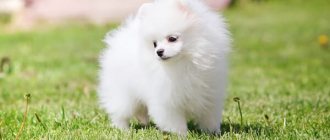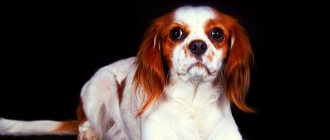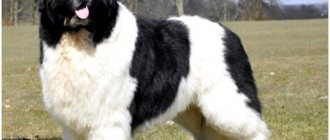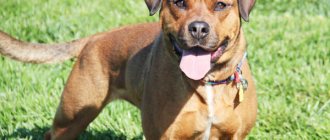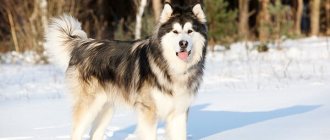According to the breed standard, Chihuahuas are allowed any color except merle.
Some colors are more common among representatives of this breed, while others are much less common.
White coloring in Chihuahuas is not common and is considered quite rare.
What else are the features inherent in white Chihuahuas?
In this article we will try to answer this question and also show photos of these cute dogs.
History of appearance
In ancient times, when the first of the ancestors of modern Chihuahuas appeared in Mesoamerica, there was no common breed type. The dogs differed in height, build, coat length and, of course, color. And probably the first of the white Chihuahuas appeared right then.
After the Spanish conquest of Mexico, the breed declined and almost disappeared completely. It was only in the middle of the 19th century that Chihuahuas began to be bred again in northern Mexico. Local residents noticed that American travelers took a liking to their pets and began selling them puppies.
Thus, Chihuahuas were brought to the United States as cute and affectionate pets. Their population was not the same - the dogs had significant differences in external characteristics, including colors. And, undoubtedly, in the second half of the 19th century, white color was found among representatives of this breed.
Read more about the history of the Chihuahua breed here.
NOTE!
According to the first breed standard, written in 1923, only the smooth type of coat was considered acceptable, although all colors existing at that time were recognized, including white.
Interesting Facts
- The name of the breed comes from the name of the largest state of Mexico, “Chihuahua”.
- The most ancient toys that depicted Chihuahuas were found in Veracruz. They were created in 100 AD. e.
- The Aztecs considered Chihuahuas to be sacred animals. When the owner died, the dog was killed and buried with him.
- When the Indians had problems with food, Chihuahuas were eaten.
- Researchers found images and figurines of long-haired Chihuahuas in the palace of the last Aztec king, Montezuma, who reigned from 1390 to 1469.
- Chihuahuas came to the USSR in the 50s of the 20th century. Fidel Castro gave a couple of dogs to Nikita Khrushchev.
Marriage or breed?
Pure white color is not considered a breed defect for a Chihuahua, unless it is one of the signs of albinism. The same applies to white with colored spots - these colors are acceptable.
Expert opinion
Kozhevin Semyon Kirillovich
Expert dog handler.
White Chihuahuas look very elegant. Considering that dogs with this coloring are rarely found, we can say that a dog of this breed with fur as white as snow is a real exclusive. However, an animal of this color may have hearing problems, so it is very important to cull from breeding dogs that pass on the deafness gene to their offspring. Caring for a white Chihuahua can be more challenging than caring for a dog of other colors.
Advantages and disadvantages
Pros:
- bright and elegant color;
- have a sociable character;
- loyal to their owners;
- always ready to defend the owner;
- they do not need a large living space;
- can scare away a thief with a loud bark;
- It’s easy to train them to a tray or diaper;
- caring for their coat is easy;
- can keep their owners company while traveling;
- They are easy to teach commands if you use the game method.
Minuses:
- not suitable as a gift for children;
- require careful and careful handling;
- if improperly raised, they can become aggressive;
- “one master” dogs - often choose one person in the family, who becomes their only authority;
- need a special approach when training;
- many Chihuahuas have a cocky disposition and can even attack large dogs;
- jealous;
- do not get along well with dogs of other breeds.
IMPORTANT!
Very small dogs of this breed, weighing less than 500 grams, are sickly and do not live long.
Conclusion
Representatives of this breed are ideal for people with any temperament and hobbies. And following the basic rules will help to achieve the desired coat color and will protect against the occurrence of puppies with the M gene in the family.
When planning to have an offspring, you need to first think about the baby’s health. If the four-legged parents did not have pathologies, then there is every chance of counting on a strong dog. The Chihuahua will become a devoted companion, a reliable nanny, and a full-fledged member of the family.
The Chihuahua knows how to adapt to the owner’s character and senses his mood.
Keeping a miniature friend is easy. The main thing is to strictly adhere to the diet, which should be balanced, and monitor the dog’s hygiene.
Short-haired pets cause less worries. They do not require regular brushing.
Dimensions, weight and other features
According to the breed standard , the height of these dogs should not exceed 23 cm at the withers, and their weight can range from 0.5 to 3 kg.
The Chihuahua is a proportionally built and elegant dog of small size and, preferably, a square or similar format.
The head has a rounded shape. The stop is clearly defined. The muzzle is short, wider at the base, tapering towards the nose.
The ears are erect, triangle-shaped, widely spaced, and quite large in size.
The eyes are large, round, preferably dark brown.
The color of the nose is black, but brownish is also acceptable.
The neck is long and graceful. The back is straight, turning into a sloping croup. The chest is voluminous, wide and quite deep, reaching to the elbows.
The limbs are straight and parallel, the length of the hind legs should slightly exceed the length of the front legs.
The tail is not docked. It is of medium length and set quite high. If the dog is long-haired, then its tail is abundantly covered with fine hair, forming something like a plume.
The white Chihuahua should have a regular scissor bite.
What are the varieties?
Smooth-haired
The smooth-haired variety of Chihuahua has a smooth, silky coat that lies close to the body. The presence of undercoat and its thickness do not matter.
Shorthair
The short-haired variety of the breed is transitional between smooth-haired and long-haired. The hair of these dogs is slightly longer than that of smooth-haired white Chihuahuas, but shorter than that of long-haired ones.
NOTE!
Shorthaired Chihuahuas are considered a breeding stock and are out of breed.
Longhair
The white coat of long-haired Chihuahuas reaches a considerable length; it forms feathers on the neck, paws and along the edges of the ears, which looks very elegant. The hairs themselves are thin and soft, but they should not be excessively long and flutter or cascade.
Mini
The weight of these dogs does not exceed 1.5 kg, but is usually less. The lower weight limit allowed for white mini Chihuahuas is 1 kg.
Micro
Micro Chihuahuas are the smallest of all representatives of this breed. The weight of these white dogs is 0.5-1 kg.
Cobby
White Chihuahuas of this type have a stocky build. They have a relatively large head with a rounded forehead and a rather short muzzle, expressive bulging eyes and widely spaced, not too large ears. Their body is muscular, their movements are energetic and quite strong.
Dir
White Chihuahuas of the Deer type look like porcelain figurines: they are slender, elegant and graceful, and in their structure they resemble miniature deer. They have slightly elongated heads with a rather long muzzle, and their movements are light and agile.
What do boys and girls look like and how do they differ?
Female Chihuahuas are slightly larger than males, which is why they are more successful in shows.
Males have a square shape, while females have a more elongated body, which is associated with their reproductive functions.
Girls also have a more graceful and thin neck.
Dogs also differ in temperament . Females are calmer, balanced and peace-loving, but aggressive in terms of protecting their offspring, and can be angry. Males are hot-tempered, active, the first to get into fights, and less well trained.
Color options
White Chihuahuas can have different color variations:
- pure white . Rarely seen and highly prized among breeders;
- two- color With this color, small colored spots are located on the main white background. Their color can be either black or red, which are quite common, or rarer shades - cream, blue, chocolate, lilac, sable, wolf, tiger;
- tricolor . Scattered across the white background are small spots of any other, darker color, complemented by a reddish polpalm;
- speckled _ White color with small specks of any darker shade.
IMPORTANT!
The merle color (marble and tan) is considered unacceptable for this breed, since in Chihuahuas it carries a lethal gene. Dogs with this color are not allowed for breeding.
What does the price depend on?
First of all, the price of a dog depends on its physical characteristics. Such as:
- Gender of the dog, females are cheaper.
- Size, the larger the dog, the cheaper it is.
- Length of coat, dogs with long coats are cheaper.
- Coat color (rare ones include chocolate, blue, brindle).
- Chihuahuas with a long muzzle and long legs are correspondingly cheaper.
Among other things, the price of a breed may depend on factors such as:
- Availability of passport and pedigree.
- Availability of awards and achievements, prizes in competitions.
- Purpose of sale (for example, profit, urgent need, etc.).
- Place of purchase (nursery or private owner).
Does color change with age?
Even if a Chihuahua puppy was born completely white, this does not mean that he will remain with fur as white as snow. Many of the puppies fade with age and become light cream or grayish.
You can find out whether the white color will change if you look closely at the puppy’s coat - in true white Chihuahuas it will remain without the slightest sign of darkening. And if the undercoat contains hairs of fawn, cream or grayish shades, then the dog will change color to a darker tone.
Change in fur color saturation
Often there is a change in the saturation of the coat of a Chihuahua. As a rule, a similar phenomenon is observed in puppies under 1 year of age.
When hair pigmentation is just being formed, the pigment is distributed throughout the hair. Saturation may decrease or increase. For example, a fawn color can lighten to beige, or, on the contrary, intensify to red (golden). It is difficult to predict such a change, but it is more often observed in puppies with light colors.
Deviations in the shade of fur are also possible in adult individuals in case of serious damage to the nervous system, internal organs, vision or hearing, sometimes for completely unknown reasons. There are rumors that even from food. And in old age, there may be a slight or significant appearance of gray hairs on the dog’s face and body, most noticeable in sunlight.
What color did you like?
Naturally, I presented to your attention only a small part of the existing Chihuahua colors. In fact, there are more than 90 of them, and even a professional can find it difficult to navigate them all. They all represent different color combinations listed above. But it is not at all necessary to know them all, because the choice is limited by the supply on the market and your financial capabilities. Unique and rare colors cost a lot of money. There is no need to chase luxury and exclusivity, because next to you there are many newborn Chihuahua puppies who are looking forward to their owner, affection and care!
Please write in the comments which of the presented color options did you like best? I will also be glad if you share this material on social networks by clicking on the buttons below. Well, I’m always ready to listen to criticism and suggestions on the topic of the article, because... I could also be wrong about something.
Rules of care
White Chihuahuas do not require complex care for their coat. Short-haired dogs only need to be brushed twice or three times a week, while long-haired dogs need to be combed daily to prevent tangling.
The eyes, ears and teeth of these dogs also do not require complex care - they need to be examined daily and cleaned as needed. To remove plaque, you can give your pet special toys or treats.
Dogs of this breed must be protected from hypothermia and overheating, which is why they should not be allowed to run in the open sun in the heat, or be exposed to rain or snow.
In order to protect your dog's white coat from contamination, it is recommended to cover your pet with clothes before going for walks.
Chihuahuas will need clothing both in the off-season and in winter. Therefore, it is necessary to purchase at least demi-season and insulated overalls for your dog. Even indoors, if it is cool there, it is recommended to dress your pet in a sweater or blanket.
Read more about caring for your Chihuahua here.
How to choose a puppy?
In order to buy a Chihuahua, and not a mestizo or a small mongrel, you should purchase a puppy from a nursery or from a reputable breeder.
When choosing a white puppy, you need to pay special attention to his health and be sure to check how well he hears, since white dogs of any breed can have congenital deafness.
It is undesirable to buy a baby with a lack of pigmentation - a pink nose and lack of black edging of the eyelids and lips. In this case, pale blue eyes should be especially wary, as they may be a sign of albinism.
In addition, the puppy should not have sour eyes, dirt in the ears, bald spots or rashes on the skin.
NOTE!
A healthy Chihuahua puppy looks active and cheerful, he favorably perceives the appearance of strangers and is not averse to getting to know them. Cowardice or aggressiveness, as well as hyperactivity, can be signs of an unstable psyche.




